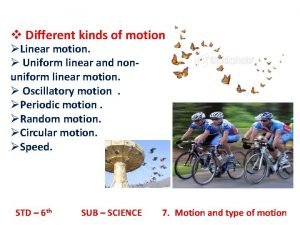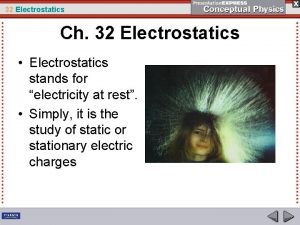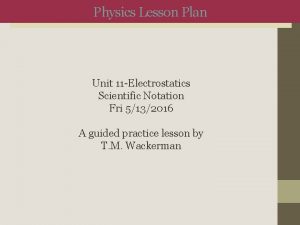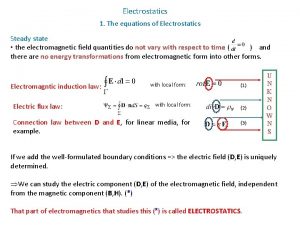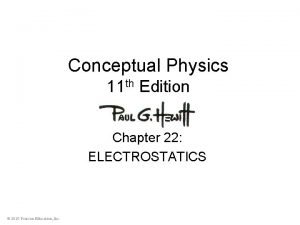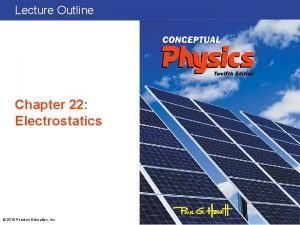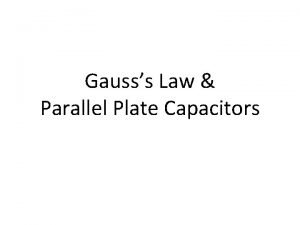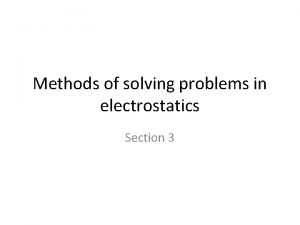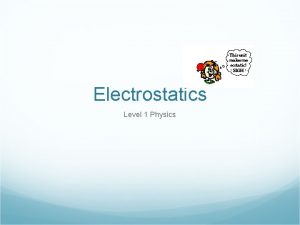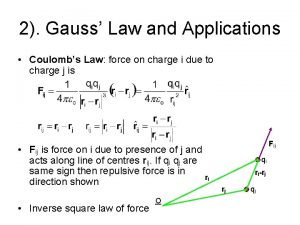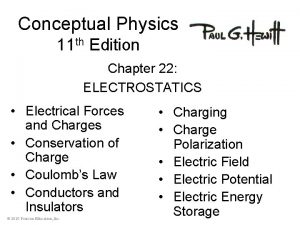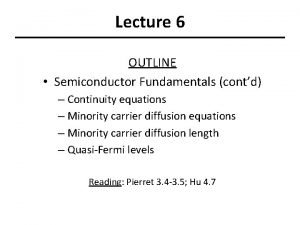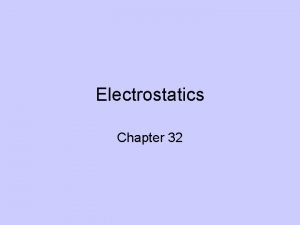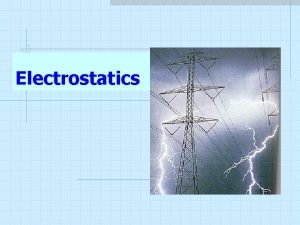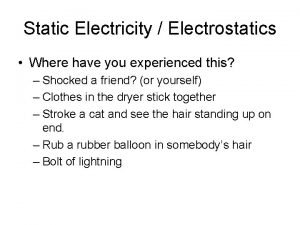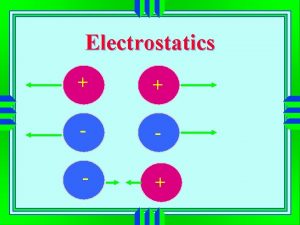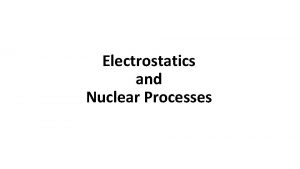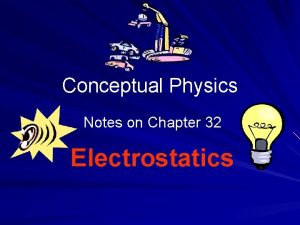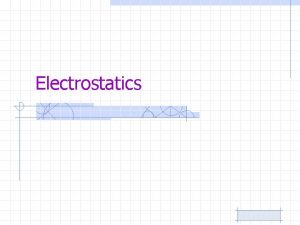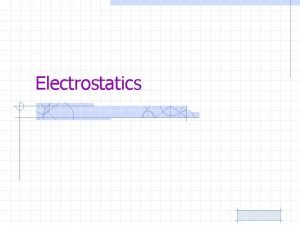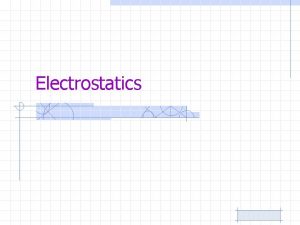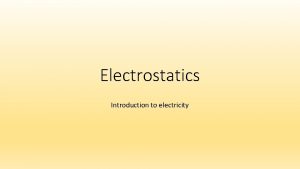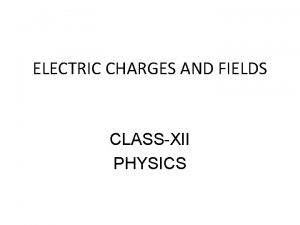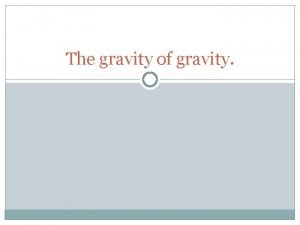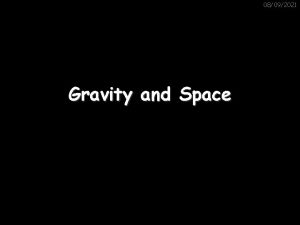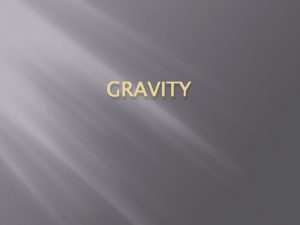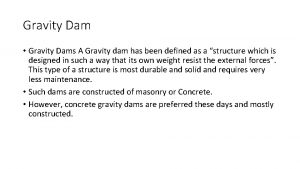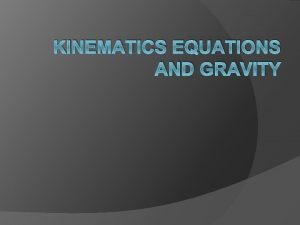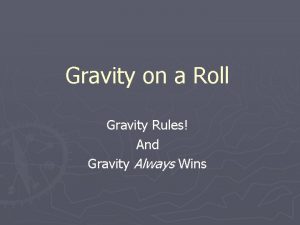Electrostatics Uniform Fields Fields Gravity Field g Field


























- Slides: 26

Electrostatics Uniform Fields

Fields Gravity Field g Field strength Also the acceleration of gravity Only 9. 8 m/s 2 on Earth’s surface. Leave the surface and g changes Electric Field E Field strength Does not give acceleration directly Different in every problem (there is no 9. 8 equivalent)

Fields of Flat Objects Charged plates usually consist of two equal sized plates separated by a distance d. The electric field between two charged plates most closely resembles the gravity field close to the earth, where the flat earth appears most similar to the flat plates. + + + + + sky m g m m − ground m E+ + − − − − To find the direction of each field test it with a test mass or test charge. Position an imaginary mass or charge at the location where you want the field direction. Then determine the direction that the test mass or charge will move. There is only one kind of mass, but two kinds of charge. Use a positive test charge, since positive charges move in the same direction as the electric field.

Force on Objects Placed in the Field + + + + + sky m g Fg − ground + E FE FE − − − − − When a mass is placed in the gravity field of the earth, the earth’s gravity field puts a force on the mass. When charges are placed in an electric field, the electric field puts a force on the charges. The direction of force is the same as the direction of the field. The direction of force on positive charges matches field direction. However, negative charges move opposite the field (minus = opposite).

Force on Objects Placed in the Field + + + + + sky m g Fg + E FE − ground − − − How do you solve for acceleration of each particle ? Now how would you solve for the distance moved, the time traveled, and the final speed? FE − − − Kinematics

Two Types of Force and Field Problems Static Charges placed inside an electric field remain stationary. This results when forces are in equilibrium Strategy: Use balanced forces. Set opposite forces equal to each other. The sum of forces and acceleration is zero. Dynamic Charges placed inside an electric field accelerate. This occurs when forces are unbalanced. Strategy: Sum forces to find acceleration, and then use kinematics to find speed, distance, and time.

Example 1 Milikan’s Oil Drop Milikan suspended a charged oil drop between two charged plates as shown in the diagram at the right. Solve for the charge on the oil drop. + + + FE − Fg − − − Milikan ran several trials. His results consisted of charge values such as 6. 4× 10 -19 C , 3. 2× 10 -19 C, 1. 6× 10 -19 C, and 4. 8× 10 -19 C. All of these values are multiples of 1. 6× 10 -19 , and he never recorded a result smaller than 1. 6× 10 -19 C. Milikan concluded that on trials with a charge of 1. 6× 10 -19 C the oil drop held one extra electron, and that 1. 6× 10 -19 C was the charge of an electron. The other trials contained more than one electron. This means that all charge is a multiple of the charge on one electron, and charge is conserved.

Example 2 A spherical conductor has a charge of − 8. 0 μC and a mass of 5. 0× 10− 2 kg. It is tied to a string attached to the ceiling. The room has an electric field passing through it, which causes the charged spherical mass to hang at an angle of 30 o from the vertical as shown in the diagram. a. 30 o − 0. 8 μC Draw a FBD showing the forces acting on the sphere. When an object is at rest forces are often the key to the problem. Start by drawing a FBD. Then remember that the force vectors have to cancel when drawn tail to tail, or add to zero if drawn tip to tail. This time we include gravity. If you can tie a string to the mass, then it is certainly large enough that gravity matters. T FE Fg

Example 2 A spherical conductor has a charge of − 8. 0 μC and a mass of 5. 0× 10− 2 kg. It is tied to a string attached to the ceiling. The room has an electric field passing through it, which causes the charged spherical mass to hang at an angle of 30 o from the vertical as shown in the diagram. 30 o b. Calculate the force of electricity acting on the sphere. Tip to tail the vectors form a right triangle. Fg is easy to calculate. 30 o T Use right triangle trig to find FE. FE

Example 2 A spherical conductor has a charge of − 8. 0 μC and a mass of 5. 0× 10− 2 kg. It is tied to a string attached to the ceiling. The room has an electric field passing through it, which causes the charged spherical mass to hang at an angle of 30 o from the vertical as shown in the diagram. c. 30 o Determine the strength of the electricity field generating the force on the sphere. 30 o T d. State the direction of the electric field. −x The negative charge is being forced to the right. Negative charges move opposite the field, so the field must be to the left.

Possible Uniform Electric Field − − + + − + − − − + − + + + + − − − − − + + + + + Charged plates are the most similar to the uniform gravity field found near the surface of a large mass, like Earth. But, plates can be oriented in different ways, where at the Earth’s surface we only consider an up/down arrangement. And others, including pointing into and out of this screen. Always think 3 D.

Stationary Charge Released in a Uniform Electric Field Positive charges follow the electric field lines. Since positive charges move with the field they define the direction the electric field direction. If the field is down positive charge move down. If positive charges move down the field in down. However, negative charges (the opposite, wrong way, particle) move opposite the electric field. They fall up toward positive. + + + + − − − −

Object moving in direction of the Field In gravity the particle is thrown downward and accelerates (forces in direction of motion cause +a). In electricity positive particles accelerate (forces in direction of motion cause +a). But, negative particles decelerate (forces opposing motion cause −a). Negative sign means opposite. v 0 M + + + v 0 − m v 0 − − −

Particle moving opposite the Field In gravity the particle is thrown upward and decelerates (forces opposing motion cause −a). In electricity positive particle decelerate (forces opposing motion cause −a). But, negative particles accelerate (forces in direction of motion cause +a). Negative sign means opposite. m M v 0 + v 0 − v 0 + + + − − −

Example 3 E − − − − + + + + An electron is located at a point in space where the electric field has a magnitude 30 N/C in the positive x-direction. a. Determine the magnitude of force on the electron. . Assume the simplest case: a uniform field consisting of parallel field lines. While we were never told what created this field, we know it has to have been plates. If it helps to solve the problem draw them or imagine them. F You have a field and a single charge try: Constants , like the charge and mass of an electron will be found on the constant page. b. Determine the direction of force on the electron. . 1 st method: Negative charges are opposite particles. Field +x , force is −x 2 nd method: Objects released from rest accelerate in the direction of the force acting on them. Which way will the electron go. −x

Example 1 FE − − − − + + + + An electron is located at a point in space where the electric field has a magnitude 30 N/C in the positive x-direction. c. Determine the acceleration of the electron. d. If the electron is released from rest, how long will it take to travel 20 cm.

Motion Perpendicular to a Uniform Field Close to a large mass the gravity is nearly parallel, and is uniform in magnitude. A mass that moves perpendicular to this field will experience projectile motion. Charges moving in electric fields also experience projectile motion. m v 0 M

Motion Perpendicular to a Uniform Field The electric plate configuration that looks most like gravity is the configuration with a positive charge moving through plates where the positive plate is on top. + + + + + v 0 − − − − − Again electricity does not have a traditional up and down, and charged plates can have many configurations.

Motion Perpendicular to a Uniform Field The plates could be upside down + + + + + − − − − − + v 0 − − − − − + • If the orientation is confusing just turn the test problem upside down, or side ways. Then it will look normal. + + + + + or side ways

Motion Perpendicular to a Uniform Field The charged particle could be negative. Try to imagine all the possible scenarios. There are many. Regardless, the motion perpendicular to the field is constant velocity, while the motion parallel to the field is acceleration. + + + + + − v 0 − − − − −

Motion Perpendicular to a Uniform Field One other difference with gravity is the fact that the electric field is limited only to the region between the plates. Before entering the plates and after leaving the plates there is no electric force, so the particle has only inertia. + + + + v 0 Inertia Force field portion Projectile motion only in this region − − − Inertia

Motion Perpendicular to a Uniform Field Acceleration while in the electric field is calculated as before. This acceleration is directed along the electric field lines for positive charges It is opposite the field lines for negative charges. + + + + v 0 − − − In the diagram at the left the acceleration is directed downward, perpendicular to the initial motion.

Motion Perpendicular to a Uniform Field The projectile motion portion is analogous to a horizontal launch, with initial velocity perpendicular to the field. The projectile part only takes place during the time that the projectile is between the plates. + Therefore, the Δx displacement is equal to the length of the plates. + + + v 0 Δy − − − Δx The Δy displacement is the vertical change in motion (deflection) while between the plates.

Motion Perpendicular to a Uniform Field The formulas for x and y are the traditional horizontal launch simplifications of the kinematic equations. + + + + v 0 Δy − − − Δx

Example 4 a. The plates have an electric field E = 150 N/C and a length of 30 cm. An electron is fired between the plates, v = 8. 0× 106 m/s. Draw the path of the electron and mark the vertical deflection. + + + + Δy − – – – – b. Determine the acceleration of the electron when it is between the plates.

Example 4 c. The plates have an electric field E = 150 N/C and a length of 30 cm. An electron is fired between the plates, v = 8. 0× 106 m/s. Determine the vertical deflection + + + + Δy − – – – –
 Red fields to green fields
Red fields to green fields Gravity for dummies and dummies for gravity equations
Gravity for dummies and dummies for gravity equations Contoh soal aliran tidak seragam
Contoh soal aliran tidak seragam Which type of motion
Which type of motion How do you classify uniform and non-uniform mixtures?
How do you classify uniform and non-uniform mixtures? Types of mixtures
Types of mixtures Electrostatics
Electrostatics Static electricity tape lab
Static electricity tape lab Electrostatics lesson plan
Electrostatics lesson plan Coulomb to volt
Coulomb to volt Electrostatics
Electrostatics Conceptual physics chapter 22 electrostatics
Conceptual physics chapter 22 electrostatics Chapter 22 electrostatics
Chapter 22 electrostatics Electrostatics
Electrostatics Method of inversion electrostatics
Method of inversion electrostatics Induction charging physics
Induction charging physics Differential form of coulomb's law
Differential form of coulomb's law Conceptual physics chapter 22 electrostatics
Conceptual physics chapter 22 electrostatics The equation of continuity is
The equation of continuity is Facts about electrostatics
Facts about electrostatics This is electricity at rest
This is electricity at rest Induction vs conduction
Induction vs conduction Net charge
Net charge Joules in us units
Joules in us units Electrostatics
Electrostatics Physics classroom electrostatics
Physics classroom electrostatics Chapter 32 electrostatics conceptual physics
Chapter 32 electrostatics conceptual physics



